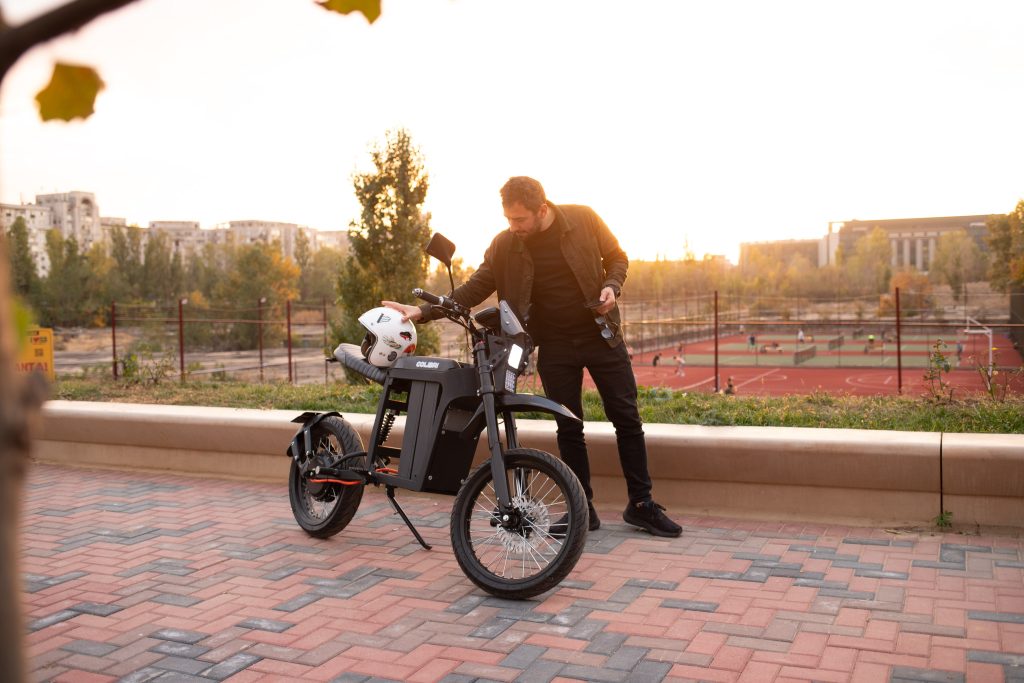Electric bikes are a great option for both quick city commutes and longer-distance trips. Not only are they much lighter and quieter than other motorized vehicles, but they are also very simple to ride, transport, and maintain.
But the question on everyone’s mind is, are electric bikes street-legal?
Riding electric bikes on public roads is permitted. Yet laws differ by location. What is legal in one place might not be allowed in another, so it’s always a good idea to check the laws and regulations set by your country, state, or municipality before getting on your bike.
This article will explore the legal and safety implications of electric bike use in Europe and the United States. We’ll discuss:
- License requirements;
- Insurance regulations;
- Rules for carrying passengers;
- Penalties for riding illegally, and more.

1. Can Electric Bikes Be Driven Legally on the Road?
Registration Requirements
Electric bikes fall into three categories with distinct registration rules. We discussed these regulations in the ‘Do eBikes Need to be Registered?’ article. Here’s a quick overview:
👉 Pedal-Assist Electric Bikes (Class 1 and Class 3—250-750W)
EUROPE: Electric bikes with 250 watts of power and assistance up to 25 km/h don’t require registration. S-Pedelecs with 500 watts of power and pedal assist up to 45 km/h must be registered in a majority of European countries, including Germany and Austria.
UNITED STATES: In New York, New Jersey, and the majority of states, there’s no need to register pedal-assist electric bikes moving at slow speeds (20 mph/~32 km/h).
👉 Throttle-Controlled Electric Bikes (Class 2—up to 750W)
EUROPE: Most countries (except the Netherlands) don’t require registration for throttle-controlled electric bikes meeting certain standards. In France, for example, these bikes must have a power output of 750 watts but are speed-limited to 20 km/h.
UNITED STATES: Throttle-controlled electric bikes in Colorado, New York, and the majority of states are treated as bicycles and don’t need to be registered.
👉 Electric Motorbikes (Class L1e-b—up to 4000W)
EUROPE & UNITED STATES: Electric motorbikes with power above 750 watts must be registered.
Traffic Lane Usage
Electric bikes can use the same pathways as traditional bicycles or motorized vehicles, depending on their classification.
👉 Pedal-Assist Electric Bikes (Class 1 and Class 3—250-750W)
EUROPE: Electric bikes have permission to travel on bike paths, bike lanes, and shared trails. But restrictions apply:
- Switzerland allows bikes with pedal assistance up to 25 km/h in marked pedestrian areas labeled ‘bicycles permitted’.
- Ireland forbids electric bikes on footpaths.
- Italy doesn’t allow electric bikes to travel faster than 6 km/h on pedestrian routes.
UNITED STATES: Washington D.C. allows electric bikes on sidewalks, O-street paths, and bicycle routes. Yet in New York, Class 1 and Class 3 bikes have specific travel rules: they must stick to bike lanes and streets where maximum speed doesn’t exceed 30 mph (~48 km/h).
👉 Throttle-Controlled Electric Bikes (Class 2—up to 750W)
EUROPE: Class 2 electric bikes, similar to Class 1 and Class 3, can use paths and trails for traditional bicycles. In the UK, all classes must ride on the left side of the lane.
UNITED STATES: Class 2 electric bikes face restrictions on certain trails, but these two-wheelers share bike and pedestrian paths with regular bicycles in Colorado and the majority of states.
👉 Electric Motorbikes (Class L1e-b—up to 4000W)
EUROPE: Class L1e-b electric bikes must use roads or motorized vehicle lanes (not cycle paths!) in most regions.
UNITED STATES: California prohibits the use of motorized bikes on specific routes, including bicycle paths, bicycle lanes, and equestrian trails. New York allows electric bikes with a speed of 20 mph (~32 km/h) to use the right lane and/or shoulder, while those with a higher top speed of 40 mph (~64 km/h) must stay in vehicle lanes.
2. What License Do You Need?
Low-powered electric bikes with pedal assistance don’t require a license, but age restrictions apply in some areas for safety reasons.
For higher-powered bikes, such as Class L1e-b, a valid driving or moped license is necessary. Learner riders must complete compulsory basic training (CBT) in certain regions to ride on public roads legally.
👉 Pedal-Assist Electric Bikes (Class 1 and Class 3—250-750W)
EUROPE: In the UK, anyone aged 14 or above can ride electric bikes without a license, whereas in Switzerland a category M driving license is required for those of the same age.
UNITED STATES: The majority of states don’t demand a driver’s license for low-speed bikes. Alaska is an exception, as it requires electric bike riders to have a Level M2 permit and be at least 14 years old.
👉 Throttle-Controlled Electric Bikes (Class 2—up to 750W)
EUROPE: A motorcycle license (class A or A1) is required for throttle-controlled electric bikes in Germany. Riders must be at least 14 years old.
UNITED STATES: Pennsylvania allows operating throttle-controlled electric bikes without a driver’s license. There’s no age limit for riding these bikes either.
👉 Electric Motorbikes (Class L1e-b—up to 4000W)
EUROPE: In the Netherlands, those who ride high-speed electric bikes must obtain a moped driving license. These bikes can also be operated with a car license in most other regions. People aged 16 and above in the UK can ride an L1e-B electric bike after completing a CBT course. But they’ll need a provisional license to take the course.
UNITED STATES: Some states, including Arkansas, prohibit individuals under 16 from riding motorized bikes. In states where it’s allowed (such as New Jersey), riders must carry a valid driver’s license to operate such vehicles. In New York, a Driver’s License +M is mandatory for bikes with a top speed of 40 mph (~64 km/h).
3. Is Insurance Mandatory?
Whether insurance is required depends on the type and specifications of the electric bike.
👉 Pedal-Assist Electric Bikes (Class 1 and Class 3—250-750W)
EUROPE: The European Court of Justice decided that electric bikes not propelled exclusively by mechanical power don’t need to be insured.
UNITED STATES: The majority of states, including Pennsylvania and Louisiana, don’t have any insurance requirements for pedal-assist electric bikes.
👉 Throttle-Controlled Electric Bikes (Class 2—up to 750W)
EUROPE: In most European countries, insurance isn’t needed for this class of electric bikes. But exceptions exist, such as in the Netherlands.
UNITED STATES: Electric bikes in Colorado, North Dakota, and the majority of states aren’t subject to the insurance regulations imposed on regular motor vehicles.
👉 Electric Motorbikes (Class L1e-b—up to 4000W)
EUROPE: Electric motorbikes classified as L1e-B must have insurance.
UNITED STATES: Motor-driven cycles are required to have insurance.

4. Are You Required to Wear Protective Gear?
Wearing a helmet is always recommended and even mandatory when riding a two-wheeler of L1e-b category. For extra safety, riders should also wear protective gear such as gloves, eye goggles, and appropriate footwear, though these are not usually required by law.
👉 Pedal-Assist Electric Bikes (Class 1 and Class 3—250-750W)
EUROPE: In France, as in many parts of Europe, wearing a helmet for low-speed electric bikes is not required, but it’s strongly advised in order to reduce the risk of potential injuries. There’s a special rule: wearing a helmet is a must for infants and children below 12 years old.
UNITED STATES: New York encourages helmet use among all riders and makes it mandatory for those aged 16-17, while Kentucky requires helmets for those under 21 years old.
👉 Throttle-Controlled Electric Bikes (Class 2—up to 750W)
EUROPE: Helmets are required for throttle-controlled bike riders in Germany.
UNITED STATES: Connecticut mandates helmets for all classes of electric bike riders.
👉 Electric Motorbikes (Class L1e-b—up to 4000W)
EUROPE: In Europe, L1e-B riders must wear protective headgear meeting motorcycle helmet standards.
UNITED STATES: North Dakota forbids individuals under 18 from riding electric bikes up to 28 mph (45 km/h) without wearing a helmet. Tennessee and New Jersey mandate helmet use for all riders, irrespective of age; helmets must conform to federal standards.
5. Can You Legally Carry a Passenger?
Electric bikes designed as two-seaters are allowed to carry passengers in both EUROPE and the UNITED STATES. But remember: passengers must have their own seat; a pillon is not allowed on single-rider bikes.
Connecticut lets anyone under the age of 16 ride as a passenger on motorized electric bikes, as long as the vehicle has been fitted with the proper equipment for passenger transport. Passenger-friendly two-wheelers, like the Colibri M22, are equipped with handholds and footrests for pillons. These features are mandatory for motorbike type approval in Europe.
No specific age restriction exists for passengers, in general. Yet in West Virginia, those under 15 must ride with someone 18 or older.
Plus, safety headgear is not optional. As an example, South Dakota requires all passengers, regardless of age, to wear a helmet.
6. What Are the Penalties for Riding an Electric Bike Illegally?
Anyone violating electric bike regulations, such as evading licensing and registration, riding in the wrong lane, or tampering with speed limiters, will be fined. Those riding under the influence are subject to more serious penalties like hefty fines, suspension of driver’s license, and potential imprisonment—depending on local laws. In Gibraltar, a rider exceeding the alcohol limit was fined £400 and lost driving privileges for six months.
EUROPE: Not following German electric bike regulations will lead to fines or the confiscation of the vehicle. Breaking UK regulations can result in bike impoundment and a fixed penalty (6 penalty points and a £300 fine).
UNITED STATES: Riders in New Jersey who use motor-driven (not pedal-assist!) bikes on public roads without a driver’s license, registration, and insurance can face fines of up to $50. If someone under the age of 14 operates a motorized bike on the streets of Tennessee, they’ll be fined for committing a delinquent act.
Conclusion
Electric bikes can be legally used on public roads, but certain conditions must be met (e.g. max power output, top speed limits, or registration).
Regulations vary across countries, states, and municipalities—and they can change at any time.
So remember to stay up to date on the electric bike laws in your area and ride a street-legal two-wheeler, such as the Colibri M22. 😁
Leave a Reply